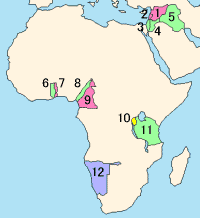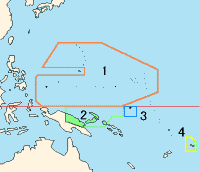| Class | Mandate | Territory | Mandate Power | Prior name | Prior sovereignty | Comments | Current state | Document |
|---|
| A | Mandate for Syria and the Lebanon | Greater Lebanon | France | Ottoman sanjaks of Beirut, Tripoli, and Mount Lebanon | Ottoman Empire | 29 September 1923 – 24 October 1945. Joined the United Nations on 24 October 1945 as an independent state and Founding Member | Lebanon |  |
| Syria | Ottoman sanjaks of Damascus, Hauran, Latakia, Homs, Hama, Aleppo, and Zor | 29 September 1923 – 24 October 1945: This mandate included Hatay Province (a former Ottoman Alexandretta sanjak), which broke away from the mandate on 2 September 1938 to become a separate French protectorate, which lasted until Hatay Province was ceded to the new Republic of Turkey on 29 June 1939. Joined the United Nations on 24 October 1945 as an independent state | Syria |
| Mandate for Palestine | Mandatory Palestine | United Kingdom | Ottoman sanjaks of Jerusalem, Nablus, and Acre | 29 September 1923 – 15 May 1948. [8] [9] [10] A United Nations Partition Plan for Palestine for peacefully dividing the remainder of the Mandate failed. [11] The Mandate terminated at midnight between 14 May and 15 May 1948. On the evening of 14 May, the Chairman of the Jewish Agency for Palestine had declared the establishment of the State of Israel. [12] Following the war, 75% of the area was controlled by the new State of Israel. [13] Other parts, until 1967, formed the West Bank of the Hashemite Kingdom of Jordan and the All-Palestine Government under the Egyptian-controlled Gaza Strip. | Israel
Palestine |  |
| Emirate of Transjordan | Ottoman sanjaks of Hauran and Ma'an | In April 1921, the Emirate of Transjordan was provisionally added as an autonomous area under the United Kingdom, [14] [15] and it became the independent Hashemite Kingdom of Transjordan (later Jordan) on 17 June 1946 upon joint ratification of the Treaty of London of 1946. | Jordan |
| Indirect | Mandatory Iraq | Various Ottoman sanjaks | The draft British Mandate for Mesopotamia was not enacted and was replaced by the Anglo-Iraqi Treaty of October 1922. Britain committed to act the responsibilities of a Mandatory Power in 1924. Iraq attained independence from the United Kingdom on 3 October 1932. | Iraq |  |
| B | Belgian Mandate for East Africa | Ruanda-Urundi | Belgium | German East Africa | German Empire | From 20 July 1922 to 13 December 1946. Formerly two separate German protectorates, they were joined as a single mandate on 20 July 1922. From 1 March 1926 to 30 June 1960, Ruanda-Urundi was in administrative union with the neighbouring colony of the Belgian Congo. After 13 December 1946, it became a United Nations trust territory, remaining under Belgian administration until the separate nations of Rwanda and Burundi gained independence on 1 July 1962. | Rwanda
Burundi | 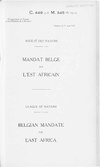 |
| British Mandate for East Africa | Tanganyika Territory | United Kingdom | From 20 July 1922 to 11 December 1946. It became a United Nations trust territory on 11 December 1946, and was granted internal self-rule on 1 May 1961. On 9 December 1961, it became independent while retaining the British monarch as nominal head of state, transforming into a republic on the same day the next year. On 26 April 1964, Tanganyika merged with the neighbouring island of Zanzibar to become the modern nation of Tanzania. | Tanzania | Equivalent document as for Ruanda-Urundi, with all articles substantially the same |
| British Mandate for the Cameroons | British Cameroon | United Kingdom | German Kamerun | Became part of the United Nations trust territories after World War II on 13 December 1946 | Part of Cameroon and Nigeria | Equivalent document as for French Cameroons, with all articles substantially the same |
| French Mandate for the Cameroons | French Cameroon | France | Under a Resident and a Commissioner until 27 August 1940, then under a governor. Became part of the United Nations trust territories after World War II on 13 December 1946 | Cameroon | 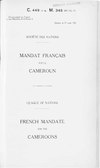 |
| British Mandate for Togoland | British Togoland | United Kingdom | German Togoland | British Administrator post filled by the colonial Governor of the British Gold Coast (present day Ghana) except 30 September 1920 – 11 October 1923 Francis Walter Fillon Jackson). Transformed on 13 December 1946 into a United Nations trust territory; on 13 December 1956 it ceased to exist as it became part of Ghana. | Volta Region, Ghana | Equivalent document as for French Togoland, with all articles substantially the same |
| French Mandate for Togoland | French Togoland | France | French Togoland under a Commissioner till 30 August 1956, then under a High Commissioner as the Autonomous Republic of Togo | Togo | 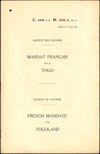 |
| C | Mandate for the German Possessions in the Pacific Ocean situated South of the Equator other than German Samoa and Nauru | Territory of New Guinea | Australia | German New Guinea | German Empire | Included German New Guinea and "the group of islands in the Pacific Ocean lying south of the equator other than German Samoa and Nauru". From 17 December 1920 under an (at first Military) Administrator; after (wartime) Japanese/U.S. military commands from 8 December 1946 under UN mandate as North East New Guinea (under Australia, as administrative unit), until it became part of present Papua New Guinea at independence in 1975 | Part of Papua New Guinea | Equivalent document as for Nauru, with all articles substantially the same |
| Mandate for Nauru | Nauru | United Kingdom | British mandate, administered by Australia, New Zealand, and the United Kingdom. Became part of the United Nations trust territories after liberation from Japanese occupation in World War II | Nauru | 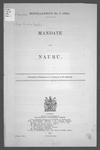 |
| Mandate for the German Possessions in the Pacific Ocean lying North of the Equator | South Seas Mandate | Japan | Known as the South Seas Mandate. Became part of the United Nations trust territories and administered by the United States after World War II | Palau
Marshall Islands
Federated States of Micronesia
Northern Mariana Islands | Equivalent document as for Nauru, with all articles substantially the same |
| Mandate for German Samoa | Western Samoa | New Zealand | German Samoa | From 17 December 1920 a League of Nations mandate, renamed Western Samoa (as opposed to American Samoa), from 25 January 1947 a United Nations trust territory until its independence on 1 January 1962 | Samoa | Equivalent document as for Nauru, with all articles substantially the same |
| Mandate for German South West Africa | South West Africa | South Africa [23] | German South West Africa | From 1 October 1922, Walvis Bay's administration (still merely having a Magistrate until its 16 March 1931 Municipal status, hence a Mayor) was also assigned to the mandate. | Namibia | Equivalent document as for Nauru, with all articles substantially the same |

